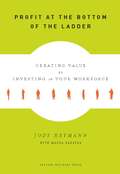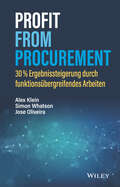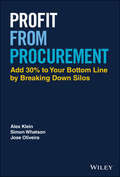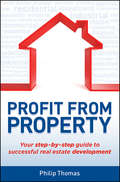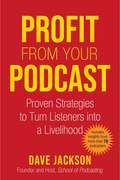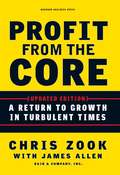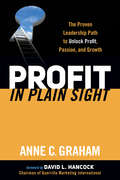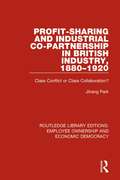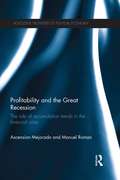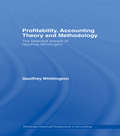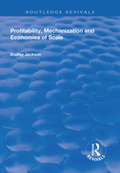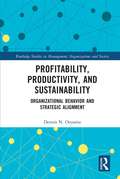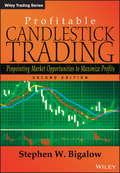- Table View
- List View
Profit and Prejudice: The Luddites of the Fourth Industrial Revolution
by Paul DonovanAvoiding prejudice will be critical to economic success in the fourth industrial revolution. It is not the new and innovative technology that will matter in the next decade, but what we do with it. Using technology properly, with diverse decision making, is the difference between success and failure in a changing world. This will require putting the right person in the right job at the right time. Prejudice stops that happening. Profit and Prejudice takes us through the relationship between economic success and prejudice in labour markets. It starts with the major changes that occur in periods of economic upheaval. These changes tend to be unpopular and complex – and complexity encourages people to turn to the simplistic arguments of ‘scapegoat economics’ and prejudice. Some of the changes of the fourth industrial revolution will help fight prejudice, but some will make it far worse. The more prejudice there is, the harder it will be for companies and countries to profit from the changes ahead. Profit is not the main argument against prejudice, but can certainly help fight it. This book tells a story of the damage that prejudice can do. Using economics without jargon, students, investors and the public will be able to follow the narrative and see how prejudice can be opposed. Prejudice is bad for business and the economy. Profit and Prejudice explains why.
Profit at the Bottom of the Ladder
by Jody HeymannMost managers assume that surviving, especially in recessions, requires slashing wages, benefits, and other workforce expenses. And lowest-skilled workers are often viewed as the most expendable.In Profit at the Bottom of the Ladder, Jody Heymann overturns these assumptions. Drawing from thousands of interviews with employees from front line to C-suite at companies around the world, Heymann shows how enterprises have profited more by improving working conditions.She also demonstrates that lower-skilled employees - in call centers, repair services, product assembly - aren't expendable. They can determine 90 percent of companies' profitability. High performers positively shape customers' perceptions of businesses, driving satisfaction and loyalty.To attract, train, and retain top-caliber people in these roles, you must enhance working conditions, creating a system in which your company and its employees profit together. Profit at the Bottom of the Ladder shows what works - from stock options for bakers to flexibility for factory workers to career tracks in call centers.Featuring cases from companies around the globe - including a leading concrete manufacturer in India, a top European pharmaceutical firm operating in China, and successful U.S. manufacturers - this book shows how real organizations are excelling financially by strengthening frontline employees' working conditions.
Profit from Procurement: 30% Ergebnissteigerung durch funktionsübergreifendes Arbeiten
by Alex Klein Simon Whatson Jose Oliveira"PROFIT FROM PROCUREMENT: 30 % Ergebnissteigerung durch funktionsübergreifendes Arbeiten" liefert einen aufschlussreichen, überzeugenden und frischen Blick auf ein Thema, das in der Regel 50 % der Gesamtkosten eines Unternehmens ausmacht: der Einkauf. Alex Klein, Simon Whatson und Jose Oliveira, Führungskräfte der weltweit größten Einkaufsberatung, zeigen die Grenzen des traditionellen, funktional isolierten Ansatzes für den Einkauf auf. Sie demonstrieren, wie erhebliche EBITDA-Gewinne erzielt werden können, indem der Einkauf aus dem Backoffice herausgelöst und in die Lage versetzt wird, die Kostenbasis eines Unternehmens grundlegend zu verändern. Die Autoren liefern praktische Strategien und Beispiele aus ihrer Arbeit mit den weltweit führenden Unternehmen, um Ihnen zu helfen, das Gewinnpotenzial Ihres Unternehmens freizusetzen. Das Buch bietet den Lesern einen praktischen und konkreten Fahrplan für die Optimierung, Integration und den Einsatz der Beschaffungskapazitäten eines Unternehmens, um eine weniger isolierte und wirkungsvollere Funktion zu schaffen. Die Leser werden lernen: - wie sie die Transformation des Einkaufs in ihrem Unternehmen planen; - wie sie sicherstellen können, dass ihr Team über die für den kommenden Wandel erforderlichen Fähigkeiten verfügt; - wie man den Einkauf neu positioniert, um zum Vorreiter funktionsübergreifender Veränderungen zu werden; - wie sie neue Themen wie Digitalisierung und Nachhaltigkeit in ihre Beschaffungspläne integrieren; - wie man sicherstellt, dass sich Effizienzsteigerungen im Einkauf vollständig im Gewinn niederschlagen. "PROFIT FROM PROCUREMENT" ist die perfekte Lektüre für C-Suite-Führungskräfte und Einkaufsexperten in Unternehmen jeder Größe und gehört in das Bücherregal jedes Mitarbeiters und jeder Führungskraft, die mit Unternehmensabläufen und Gewinnstrategien betraut ist. Direkt, umsetzbar und praxiserprobt ist das Buch ein Muss für jede Führungskraft, die mit Hilfe des Einkaufs einen positiven Einfluss auf den Gewinn ausüben möchte.
Profit from Procurement: Add 30% to Your Bottom Line by Breaking Down Silos
by Alex Klein Simon Whatson Jose OliveiraYour lack of focus on Procurement is limiting your profits. Multiply them by making Procurement a company-wide priority. Profit from Procurement: Add 30% to Your Bottom Line by Breaking Down Silos delivers an insightful, compelling, and fresh take on a subject that typically comprises 50% of a business's total costs: Procurement. Alex Klein, Simon Whatson and Jose Oliveira, leaders at the world's largest dedicated Procurement consultancy, highlight the limitations of the traditional, functionally siloed approach to Procurement, and demonstrate how significant EBITDA gains can be made by lifting Procurement out of the back office and enabling it to fundamentally reset a company's cost base. Its accessible, frank, and refreshing style, combined with practical, actionable advice, based on the authors' extensive real-life experience, make it a must read for any executive looking to make an impact through Procurement. The book offers readers a practical and concrete roadmap to optimizing, integrating, and deploying a company’s Procurement capabilities, creating a less siloed, more impactful function. Readers will learn how to: Plan their company's Procurement transformation Reskill teams for the coming change Reposition the Procurement function to become the driver of cross-functional change Integrate new topics such as digitalization and sustainability into their Procurement roadmaps Ensure that Procurement efficiencies are fully reflected in bottom-line profits Perfect for C-Suite executives and Procurement professionals at companies of all sizes, Profit from Procurement belongs on the bookshelves of every employee and leader tasked with company operations and profit strategy.
Profit from Property
by Philip ThomasProfit from Property is the must-have guide for anyone who wants to make money out of property development.Expert author Philip Thomas will show you step by step how to develop property the smart way--from purchasing the best development opportunity, to financing the development, through to completion and disposal of the property. His fool-proof system will have you buying, managing, developing and selling property like an expert, whether you're a first-time developer or an experienced investor wanting to make more out of your portfolio.Inside you'll discover:money-making strategies for residential, commercial and industrial propertieshandy tips and case studies that will save you time, cash and stressa proven development model that you can start using immediately with resultshow to become a successful property developer without a huge amount of cash behind you.The best time to get into property is now. Read this book today and start profiting from property tomorrow!
Profit from Your Podcast: Proven Strategies to Turn Listeners into a Livelihood
by Dave JacksonMethods and Advice for Making the Most of Your Podcast—Pricing, Sponsors, Crowdfunding, and More Pick up any book on podcast monetization, and you will find 90 percent of it only covers how to launch a podcast. If you already have a podcast, you have that information; you&’re ready for the next step. Profit from Your Podcast provides top strategies and real-life examples of podcast monetization. This book is more than what to do. It also tells you how to do it. Chapters cover such topics as: How to Grow Your AudienceHow to Set Your PricingUnderstanding Advertising JargonHow to Find SponsorsBest Strategies for Making Money as an AffiliateMaster Strategies for CrowdfundingHarnessing the Power of Webinars and EventsThe Top Tools to Make Your Job Easy Built on the author&’s fifteen years of experience in podcasting, this action-packed guide will benefit new and veteran podcasters. Get clear on who your audience is and what they want, deliver value, and build an engaged audience that wants to give you money. Leverage your relationships and the integrity you have built through your podcast to create multiple streams of income. Profit from Your Podcast gives you the tools to do it all.
Profit from the Core
by James Allen Chris ZookWhen Profit from the Core was published in 2001, it became an international bestseller, helping hundreds of companies find their way back to profitable growth after the bursting of the Internet bubble. The 2007 global financial meltdown reaffirmed the perils of pursuing heady growth through untested strategies, as firms in industries from finance to retailing to automobiles strayed too far from their core businesses and suffered the consequences.In this updated edition of Profit from the Core, authors Chris Zook and James Allen show that a renewed focus on the core is more critical than ever as firms seek to rebuild their competitive advantage coming out of the downturn-and that a strong core will be the foundation for successful expansion as the economy recovers. Based on more than ten years of Bain & Company research and analysis and fresh examples from firms responding to the current downturn, the book outlines what today's executives and managers need to do now to revitalize their core, identify the next wave of profitable growth, and build on it successfully.Zook and Allen explain how companies can: Develop a strong, well-defined core and use it to establish a leadership position Follow the golden rule of strategy: discourage competitors from investing in your core Assess whether your core is operating at its full potential Uncover hidden assets in your core that provide the seeds for new growth Find a repeatable formula to apply core business strengths in adjacent marketsBuilding on powerful and proven ideas to meet today's formidable business challenges, Profit from the Core is the back-to-basics strategy field guide no manager should be without.
Profit from the Core
by James Allen Chris ZookWhen Profit from the Core was published in 2001, it became an international bestseller, helping hundreds of companies find their way back to profitable growth after the bursting of the Internet bubble. The 2007 global financial meltdown reaffirmed the perils of pursuing heady growth through untested strategies, as firms in industries from finance to retailing to automobiles strayed too far from their core businesses and suffered the consequences.In this updated edition of Profit from the Core, authors Chris Zook and James Allen show that a renewed focus on the core is more critical than ever as firms seek to rebuild their competitive advantage coming out of the downturn-and that a strong core will be the foundation for successful expansion as the economy recovers. Based on more than ten years of Bain & Company research and analysis and fresh examples from firms responding to the current downturn, the book outlines what today's executives and managers need to do now to revitalize their core, identify the next wave of profitable growth, and build on it successfully.Zook and Allen explain how companies can: Develop a strong, well-defined core and use it to establish a leadership position Follow the golden rule of strategy: discourage competitors from investing in your core Assess whether your core is operating at its full potential Uncover hidden assets in your core that provide the seeds for new growth Find a repeatable formula to apply core business strengths in adjacent marketsBuilding on powerful and proven ideas to meet today's formidable business challenges, Profit from the Core is the back-to-basics strategy field guide no manager should be without.
Profit from the Core
by James Allen Chris ZookWhen Profit from the Core was published in 2001, it became an international bestseller, helping hundreds of companies find their way back to profitable growth after the bursting of the Internet bubble. The 2007 global financial meltdown reaffirmed the perils of pursuing heady growth through untested strategies, as firms in industries from finance to retailing to automobiles strayed too far from their core businesses and suffered the consequences.In this updated edition of Profit from the Core, authors Chris Zook and James Allen show that a renewed focus on the core is more critical than ever as firms seek to rebuild their competitive advantage coming out of the downturn-and that a strong core will be the foundation for successful expansion as the economy recovers. Based on more than ten years of Bain & Company research and analysis and fresh examples from firms responding to the current downturn, the book outlines what today's executives and managers need to do now to revitalize their core, identify the next wave of profitable growth, and build on it successfully.Zook and Allen explain how companies can: Develop a strong, well-defined core and use it to establish a leadership position Follow the golden rule of strategy: discourage competitors from investing in your core Assess whether your core is operating at its full potential Uncover hidden assets in your core that provide the seeds for new growth Find a repeatable formula to apply core business strengths in adjacent marketsBuilding on powerful and proven ideas to meet today's formidable business challenges, Profit from the Core is the back-to-basics strategy field guide no manager should be without.
Profit in Plain Sight: The Proven Leadership Path to Unlock Profit, Passion, and Growth
by Anne C. GrahamAlmost every business leader admits that too often, they have a great year on the top line, but too little to show on the bottom line. And when they can’t or won’t take on more debt, they stay stalled, unable to fund the people, technology, equipment, facilities, acquisitions or expansion that will help their business grow and thrive. With often-overlooked solutions to the five core challenges to building a strong bottom line to fund growth, "Profit in Plain Sight" resolves that dilemma.This book will resonate with every business leader at any level who is tired of saying or hearing “We don’t have the budget for that” and wants to grow their bottom line and their business by selling more products and services, to more of the right customers, at higher prices, and lower costs. . . in less time than they’re spending on email.The 55 Profit Accelerators contained in "Profit in Plain Sight" were synthesized from over 30 years of business experience, often in tough turnaround situations. They’re proven, they’re classic, they work, they’re never taught in business schools, and they have nothing to do with conventional cost-cutting or accounting techniques. Instead, they deliver take-it-to-the-bank results.
Profit over Privacy: How Surveillance Advertising Conquered the Internet
by Matthew CrainA deep dive into the political roots of advertising on the internet The contemporary internet&’s de facto business model is one of surveillance. Browser cookies follow us around the web, Amazon targets us with eerily prescient ads, Facebook and Google read our messages and analyze our patterns, and apps record our every move. In Profit over Privacy, Matthew Crain gives internet surveillance a much-needed origin story by chronicling the development of its most important historical catalyst: web advertising.The first institutional and political history of internet advertising, Profit over Privacy uses the 1990s as its backdrop to show how the massive data-collection infrastructure that undergirds the internet today is the result of twenty-five years of technical and political economic engineering. Crain considers the social causes and consequences of the internet&’s rapid embrace of consumer monitoring, detailing how advertisers and marketers adapted to the existential threat of the internet and marshaled venture capital to develop the now-ubiquitous business model called &“surveillance advertising.&” He draws on a range of primary resources from government, industry, and the press and highlights the political roots of internet advertising to underscore the necessity of political solutions to reign in unaccountable commercial surveillance.The dominant business model on the internet, surveillance advertising is the result of political choices—not the inevitable march of technology. Unlike many other countries, the United States has no internet privacy law. A fascinating prehistory of internet advertising giants like Google and Facebook, Profit over Privacy argues that the internet did not have to turn out this way and that it can be remade into something better.
Profit with Honor: The New Stage of Market Capitalism
by Daniel YankelovichThis wise and optimistic book examines the rampant scandals that plague American corporations today and shows how companies can reverse the resulting climate of mistrust. By seizing the opportunity to address some of the nation's--and the world's--most serious problems, business can strengthen its reputation for integrity and service and advance to a new stage of ethical legitimacy. Daniel Yankelovich, a social scientist and an experienced member of the corporate boardroom, describes the toxic convergence of cultural and business trends that has led inexorably to corporate scandals. Yet he offers reassurance that opportunity exists for positive change. Creative business leaders can advance market capitalism to its next stage of evolution, building upon business norms that simultaneously emphasize the legitimacy of profit making and the importance of the care that companies give to employees, customers, and the larger society. The book asserts that American culture has abandoned its old tradition of enlightened self-interest, of "doing well by doing good. " A narrow legalism has taken over ("I didn't break the law; therefore I didn't do anything wrong"). Yankelovich argues that attempts to deal with such flawed ethical norms by means of more laws and regulations cannot succeed. He offers a series of case histories to show how and why stewardship ethics can strengthen individuals, corporations, the nation, and the world economy.
Profit, Accumulation, and Crisis in Capitalism: Long-term Trends in the UK, US, Japan, and China, 1855–2018 (Routledge Frontiers of Political Economy)
by Minqi LiKarl Marx hypothesized that there is a long-term tendency for the profit rate to fall in capitalist economies. Immanuel Wallerstein hypothesized that capitalist development tends to drive up labor cost, material cost, and taxation cost. This book evaluates Marx’s and Wallerstein’s hypotheses by studying the long-term movement of the profit rate and contributing factors in major capitalist economies. During the twentieth century, leading capitalist economies largely succeeded in stabilizing the profit rate. However, the current decline of the profit rate in China may precipitate the global capitalist economy into a new major crisis. As economic growth slows down in all major capitalist economies, Marx’s original hypothesis may be verified by the global economic events in the twenty-first century.
Profit-sharing and Industrial Co-partnership in British Industry, 1880-1920: Class Conflict or Class Collaboration? (Routledge Library Editions: Employee Ownership and Economic Democracy #6)
by Jihang ParkIn this title, first published in 1987, the author discusses the economic and industrial circumstances in Britain under which profit-sharing and co-partnership came into being. He explores the merits and drawbacks of the system as both advocates and opponents saw them, the motivations of employers in introducing profit-sharing schemes, and the implementing of such notable schemes as that of Lever Brothers, a multinational corporation based in Britain. The author also assesses the role of profit-sharing and co-partnership in the development of modern management practices and industrial relations.
ProfitLogic
by Michael J. Roberts Richard G. Hamermesh Taz PirmohamedDescribes an "application software" company that has been through several evolutions--from consulting firm to applications service provider (ASP). The firm has received significant venture funding to pursue the ASP model but this has not worked, at least at the time the case ends. The company faces a choice: continuing with its current ASP business model, increasing its burn rate to convert to a licensed software model, or decreasing its burn rate to offer a more custom version of the ASP product.
Profitability Drivers in Professional Service Firms
by Ashish NandaThis csae presents a simple model of the drivers of profitability in a professional service partnership and conducts an empirical exploration of the determinants of profitability among AmLaw 100 firms over the period 1994 to 1999.
Profitability Ratios - The Higher the Better (Mostly): The Five You Need to Know
by Karen Berman Joe KnightProfitability ratios help you evaluate your company's ability to generate profits. While there are dozens of them, there are only five that entrepreneurs need to understand and use: gross profit margin percentage, operating profit margin percentage, net profit margin percentage, return on assets, and return on equity. This chapter is excerpted from "Financial Intelligence for Entrepreneurs: What You Really Need to Know About the Numbers."
Profitability Ratios: The Higher the Better (Mostly)
by John Case Karen Berman Joe KnightProfitability ratios help you evaluate a company's ability to generate profits. This chapter looks at five key profitability ratios that every manager should understand in order to master financial statement analysis.
Profitability and the Great Recession: The Role of Accumulation Trends in the Financial Crisis (Routledge Frontiers of Political Economy #177)
by Manuel Roman Ascension MejoradoFrom the mid-1980s, investors in the US increasingly directed capital towards the financial sector at the expense of non-financial sectors, lured by the perception of higher profits. This flow of capital inflated asset prices, creating the stock market and housing bubbles which burst when the imbalance between stagnant incomes and rising debts triggered the banking meltdown. Profitability and the Great Recession analyses these trends in profitability and capital accumulation, which the authors identify as the root cause of the financial crisis, in the context of the US and other major OECD countries. Drawing on insights from Adam Smith, David Ricardo, John Stuart Mill and Karl Marx, the authors interpret the relationship between capital accumulation and profitability trends through the conceptual lens of classical political economy. The book provides extensive empirical evidence of declining rates of US non-financial corporate accumulations from the mid-1960s and profitability trends in that sector falling from post-war highs. In contrast to this, it is shown that there was a vigorous rise of profitability in the financial sector from a 1982 trough to the early part of the twenty-first century, which led to the bloating of that sector. The authors conclude that the long-term falling accumulation trend in the non-financial corporate sector, highlighted by the bankruptcy of major automobile corporations, stands out as the underlying force that transformed the financial crisis into a fully-fledged Great Recession. This book will be of interest to students and researchers in the areas of economics, political economy, business and finance.
Profitability, Accounting Theory and Methodology: The Selected Essays of Geoffrey Whittington (Routledge Historical Perspectives in Accounting)
by Geoffrey WhittingtonAn important scholar in the history of accounting, Geoffrey Whittington's numerous articles cover a broad spectrum of the field and are both sharply insightful and extremely significant. He has made important contributions to the topics of inflation accounting, accounting theory and methodology and standard-setting, and he has conducted a number of valuable empirical studies. This remarkable collection pulls together essays and articles and encompasses his work on empirical studies based on company accounts, specification of empirical models, price change accounting, taxation and regulation, and regulation of accounting and auditing. Accompanied by a new introduction and conclusion, this significant volume will be extremely useful for historians of accounting as well as accountancy practitioners and researchers.
Profitability, Mechanization and Economies of Scale (Routledge Revivals)
by Dudley JacksonFirst published in 1998, this book introduces a new concept of profitability, called the 'efficiency rate of profit', which is defined as the ratio between the unit net margin and the unit capital requirement and shows how the efficiency rate of profit may be used in the assessment of mechanization and economies of scale. The book also shows how the efficiency rate of profit relates to the financial opportunity cost of investment, thus resolving the long-standing controversy over 'interest as a cost'. Using real-world plant-level data, the book explains fully the process of mechanization, how increasing returns to scale works at the plant level through power rule relating plant or equipment cost to capacity and how and why it is more cost effective to combine mechanization with expanding the scale of production in one combined 'package' of efficiency improvement.
Profitability, Productivity, and Sustainability: Organizational Behavior and Strategic Alignment (Routledge Studies in Management, Organizations and Society)
by Dennis N. OnyamaThis book presents an in-depth study of how the drive to optimize organizational performance can be significantly improved by investigating the causal relationships between profitability, productivity, and sustainability (PPS) through an assessment of a triple combined therapy that studies the interplay between Organizational DNA, Strategic Alignments for Value, and their implications for Sustainability. Through this approach, this volume seeks to answer critical mind-searching questions and provide useful guides as to how some firms are able to sustainably create higher value or wealth, especially through corporate entrepreneurship, or via the creation of new business models than others. In tackling the three elements of profitability, productivity, and sustainability, this book also provides greater insight through an in-depth study of the pervasively unresolved and disturbing issues surrounding the prospects of increasing the chances of success for entrepreneurial start-off ventures, making it of value to researchers, academics, and students in the fields of organizational studies, strategy, and sustainability.
Profitable Art of Service Recovery
by James L. Heskett W. Earl Sasser Jr. Christopher W.L. HartService companies often cannot prevent mistakes, but they can learn to recover from them and thereby retain an unhappy customer. Recovery begins by identifying the problem, then acting quickly to correct it. Most important, service companies should give front-line employees the authority and responsibility to do what is necessary to correct a service mistake, even if it means deviating from the rules.
Profitable Candlestick Trading: Pinpointing Market Opportunities to Maximize Profits (Wiley Trading #500)
by Stephen W. BigalowThe updated edition to one of the most popular books on technical analysis Japanese candlestick charting and analysis is one of the most profitable yet underutilized ways to trade the market. Signals created by this unique method of technical analysis-represented in the form of graphic "candlestick" formations-identify the immediate direction and effects of investor sentiment through price movements, allowing traders to profit by spotting trend reversals before other investors. This updated version of Profitable Candlestick Trading: Pinpointing Market Opportunities to Maximize Profits makes learning the method fast and easy by introducing specific patterns, as well as the psychology behind them. The book Details the most valuable aspect of technical analysis-reversal patterns-as well as reversal signals, including the Doji, the Hammer, the Hanging Man, Engulfing Patterns, and Dark Cloud Cover Explains continuation patterns and explores how they can help with the decision-making process during various trading periods Reveals how to find trading situations that have the maximum potential for profitability, the highest probability of success, and the least amount of risk Learn how to quickly search, view, and profit with candlestick formations with Profitable Candlestick Trading.
Profitable Growth Is Everyone's Business: 9 Tools You Can Use Monday Morning
by Ram CharanThe coauthor of the international bestsellerExecutionhas created the how-to guide for solving today’s toughest business challenge: creating profitable growth that is organic, differentiated, and sustainable. For many, growth is about “home runs”—the big bold idea, the next new thing, the product that will revolutionize the marketplace. While obviously attractive and lucrative, home runs don’t happen every day and frequently come in cycles. Products like Kevlar, Teflon, and the Dell business model for selling personal computers may be once-in-a-decade phenomena. A surer and more consistent path to profitable revenue growth is through “singles and doubles”—small day-to-day wins and adaptation to changes in the marketplace that build the foundation for substantially increasing revenues. The impact of singles and doubles can be huge. They are not only the basis for sustained revenue growth but, in fact, the foundation for home runs. Singles and doubles provide the discipline of execution, an absolute necessity for successfully bringing a breakthrough technology to market or implementing a new business model. Inherent in this way of thinking is the revolutionary idea that growth is everyone’s business—not solely the concern of the sales force or top management. Just as everyone participates in cost reduction, so must everyone be engaged in the growth agenda of the business. Every contact of each employee with a customer is an opportunity for revenue growth. That includes everyone from the people working in a company’s call center handling customer inquiries and complaints to the CEO. In this trailblazing book, Ram Charan provides the building blocks and tools that can put a business on the path to sustained, profitable growth. For more than twenty-five years, Ram Charan has been working day in and day out with companies around the world. The ideas he has developed for solving the profitable revenue growth dilemma facing many businesses are based on personally seeing what works in real time. These are ideas that have been tested across industries and that deliver results, and they can be put to use starting Monday morning.

